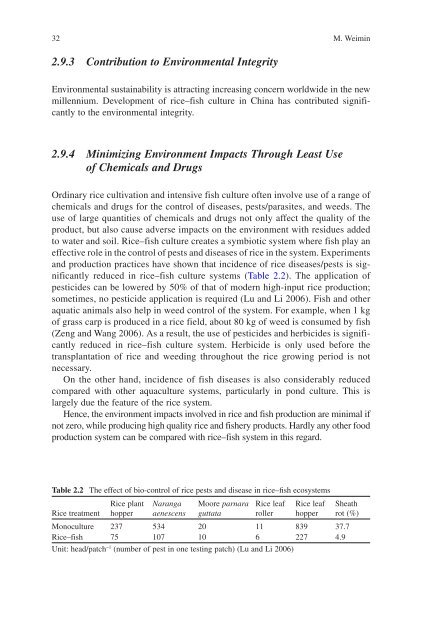Success Stories In Asian Aquaculture - Library - Network of ...
Success Stories In Asian Aquaculture - Library - Network of ...
Success Stories In Asian Aquaculture - Library - Network of ...
- No tags were found...
You also want an ePaper? Increase the reach of your titles
YUMPU automatically turns print PDFs into web optimized ePapers that Google loves.
32 M. Weimin2.9.3 Contribution to Environmental <strong>In</strong>tegrityEnvironmental sustainability is attracting increasing concern worldwide in the newmillennium. Development <strong>of</strong> rice–fish culture in China has contributed significantlyto the environmental integrity.2.9.4 Minimizing Environment Impacts Through Least Use<strong>of</strong> Chemicals and DrugsOrdinary rice cultivation and intensive fish culture <strong>of</strong>ten involve use <strong>of</strong> a range <strong>of</strong>chemicals and drugs for the control <strong>of</strong> diseases, pests/parasites, and weeds. Theuse <strong>of</strong> large quantities <strong>of</strong> chemicals and drugs not only affect the quality <strong>of</strong> theproduct, but also cause adverse impacts on the environment with residues addedto water and soil. Rice–fish culture creates a symbiotic system where fish play aneffective role in the control <strong>of</strong> pests and diseases <strong>of</strong> rice in the system. Experimentsand production practices have shown that incidence <strong>of</strong> rice diseases/pests is significantlyreduced in rice–fish culture systems (Table 2.2 ). The application <strong>of</strong>pesticides can be lowered by 50% <strong>of</strong> that <strong>of</strong> modern high-input rice production;sometimes, no pesticide application is required ( Lu and Li 2006) . Fish and otheraquatic animals also help in weed control <strong>of</strong> the system. For example, when 1 kg<strong>of</strong> grass carp is produced in a rice field, about 80 kg <strong>of</strong> weed is consumed by fish(Zeng and Wang 2006) . As a result, the use <strong>of</strong> pesticides and herbicides is significantlyreduced in rice–fish culture system. Herbicide is only used before thetransplantation <strong>of</strong> rice and weeding throughout the rice growing period is notnecessary.On the other hand, incidence <strong>of</strong> fish diseases is also considerably reducedcompared with other aquaculture systems, particularly in pond culture. This islargely due the feature <strong>of</strong> the rice system.Hence, the environment impacts involved in rice and fish production are minimal ifnot zero, while producing high quality rice and fishery products. Hardly any other foodproduction system can be compared with rice–fish system in this regard.Table 2.2 The effect <strong>of</strong> bio-control <strong>of</strong> rice pests and disease in rice–fish ecosystemsRice treatmentRice planthopperNarangaaenescensMoore parnaraguttataRice leafrollerRice leafhopperSheathrot (%)Monoculture 237 534 20 11 839 37.7Rice–fish 75 107 10 6 227 4.9Unit: head/patch −1 (number <strong>of</strong> pest in one testing patch) (Lu and Li 2006)
















